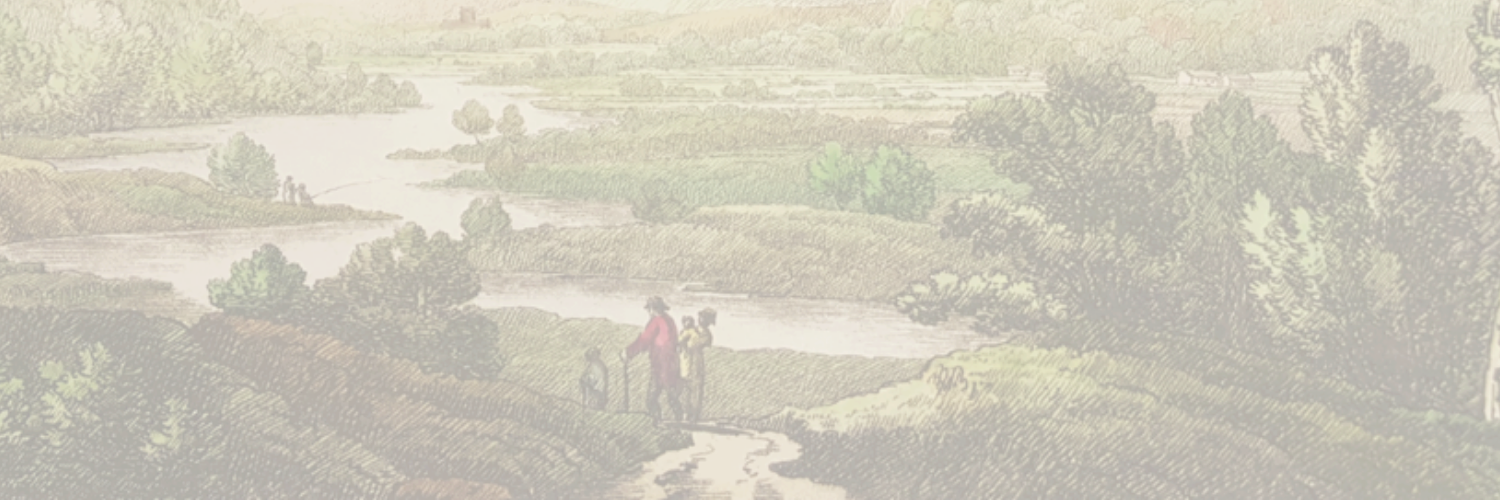William Wordsworth’s experience writing and publishing the original 1810 version of the Guide to the Lakes was unlike any other of his sixty-year literary career. As detailed in our introduction, much of this episode’s uniqueness stemmed from his serving as the de facto ghost writer for Joseph Wilkinson’s Select Views in Cumberland, Westmoreland, and Lancashire. Not only did this arrangement curtail his customary liberty to choose his own subject matter and set his own deadlines, but it also left Wordsworth largely disenfranchised in matters of when, in what format, and for what audience his work would appear. Unsurprisingly, then, the famously independent writer quickly came to regret having accepted the Select Views commission, and his correspondence from 1810 frequently bemoans having yoked himself to so “intolerable” an artist and his “drawings, or Etchings, or whatever they may be called.”
While Wilkinson served as a convenient scapegoat, the poet’s aggravations can largely be attributed to his unfamiliarity with, and ultimate unfitness for, the conventions of publishing a series of art prints. Prior to Select Views, Wordsworth had been deeply, even obsessively, involved in the publication of seven editions of his verse and one of his prose.
But all of these experiences occurred in the specific fiscal context of the English book trade, where editing, typesetting, advertising, and other upfront costs were sufficiently low (albeit far from insignificant) that the established publisher or genteel author of the early Romantic age could generally afford to underwrite a new title in hopes of recouping the investment or even turning a profit upon its release.
Publishers of prints, however—who were largely distinct from specialists in books—faced much steeper upfront costs and were therefore considerably more reluctant to risk a title’s completely flopping. Although series of collectible engravings had always been a luxury good, prices reached historic highs (even adjusting for inflation) in the early nineteenth century. By 1810, nearly two decades of war with France had exacerbated ongoing paper and labor shortages; and breakthrough, cost-cutting technologies like lithography and wood-based papermaking would not permeate the British market until the 1820s and 1830s. Meanwhile, burgeoning European and North American demand for art prints had triggered spikes in engravers’ fees, especially at the upper reaches of the market. While rates varied widely by region and in accordance with a print’s size and level of detail, elite London engravers could charge £15 or more for folio plates in 1810. Prices might easily double when working from pencil sketches like Wilkinson’s, as capturing subtle variations in shading and line weight necessitated the use of labor-intensive soft-ground etching techniques.
No surviving documents record total sales of the 1810 Select Views, but circumstantial evidence suggests a small print run of 200 or fewer copies.
If the circulation was, in fact, this low, Wilkinson almost certainly would have been required to subsidize his vanity project with personal funds. Even if, hypothetically, the engraver, W. F. Wells, offered the bargain rate of £15 per plate for folio-sized soft-ground etchings, total charges for the forty-eight engravings would have been £720. In such a scenario, Wilkinson would therefore have needed to sell 115 sets at the advertised price of 10s.6d. per installment (or £6.6s. for all twelve numbers) just to pay the engravers’ bill. And, judging from Ackermann’s ledgers for similar series, engraving expenses may well have accounted for under one-third of total production costs for Select Views.
Unfortunately, no Ackermann ledgers are known to survive for 1809–11, when, presumably, most expenditures or revenues from Select Views would have been logged. The firm’s extant payments book that begins in January 1812, however, records four disbursements to Wilkinson between the start of 1812 and February 1813 totaling £217.15s.
Without supplemental data from earlier payment books, these details obviously reveal little about the series’ overall circulation or profitability. They do, however, clarify that, like most vanity publications, Select Views was almost certainly produced at the financial risk of the author rather than the publisher. Had the series been underwritten by Ackermann, any disbursements to Wilkinson would in all probability have occurred either at the point of contract (1809) or upon receipt of the final sketches and letterpress (1810). Presuming, then, that the series was published at Wilkinson’s expense, these sizeable, and likely final, remittances represented not profits but partial reimbursements made upon receipt of late-arriving subscriber fees in 1812 and early 1813.
By most indications, the Wilkinsons were relatively affluent but not so wealthy as to be able to spend hundreds of pounds on a passion project without feeling the effects. Presumably, then, in contracting with Ackermann rather than self-publishing, the artist calculated that any added expenses would be counterbalanced by the London firm’s expertise, distribution networks, and increasingly prestigious imprimatur. Even before retaining Ackermann—or, for that matter, an engraver or letterpress writer—Wilkinson worked to secure enough subscriptions to keep the undertaking from proving financially ruinous. His first calls for subscribers appeared in November 1808, roughly six months before he made arrangements with Wells, Ackermann, and Wordsworth and over a year before the first number of Select Views appeared.
Besides publishing by subscription, another conventional safeguard Wilkinson embraced was serializing the set across an entire calendar year. On the first day of each month of 1810, subscribers to Select Views received installments typically consisting of four prints and several letterpress pages. Each number arrived in wrappers listing the month’s contents, reprinting the series’ prospectus, and reminding purchasers that “Ten Shillings and Sixpence each Number” were “to be paid for on Delivery” (figs. 1 and 2). For those financing projects like Select Views, this mode of distribution had obvious appeal, as it allowed them to spread production costs over an entire year and start recouping their investment when subscribers began making monthly payments upon receipt of the first installment.
Another clear benefit of this method was the extended window it afforded contributors to complete their assigned tasks. At the outset, the plan for Select Views was for Wilkinson to submit his finished sketches to Wells, who would then, as he completed his etchings, send proofs to Wordsworth in Grasmere. As detailed in our general introduction, this process quickly broke down; but, at least in theory, the idea was for Wordsworth to receive proofs early enough to key the “Descriptions” in his letterpress to specific drawings (fig. 3 below).
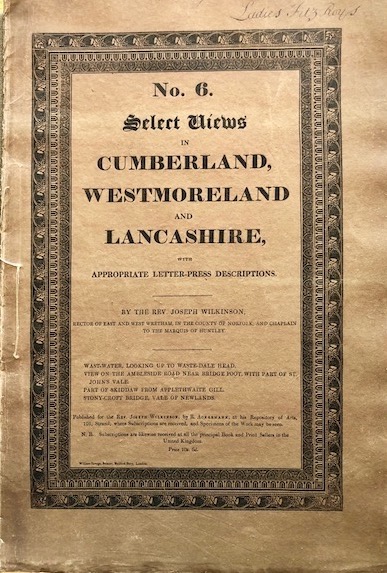
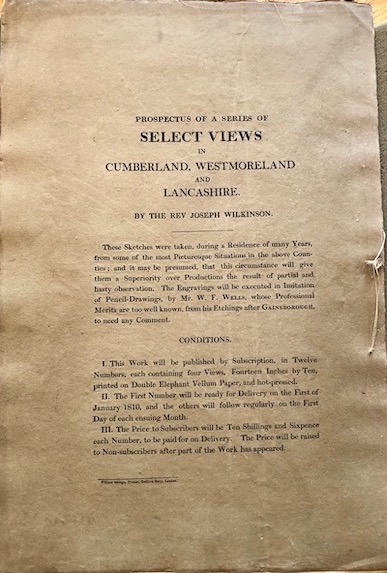
No discernible logic governs the orders in which the printed engravings were originally serialized or later reorganized in the table of contents included in the series’ final installment. The ordering of Wordsworth’s contributions was, by contrast, relatively straightforward, as his “Introduction,” “Section I,” and “Section II” were serialized, paginated, and later bound in the exact sequence in which he wrote and submitted them. Less certainty, however, has surrounded precisely when specific page ranges of his letterpress first appeared in serial numbers. Part of the confusion is owing to a 10 May 1810 letter in which the poet informs Lady Beaumont, “I am very happy that you have read the Introduction [to Select Views] with so much pleasure, and must thank you for your kindness in telling me of it.”
This has understandably led many scholars to assume all thirty-four printed pages of Wordsworth’s “Introduction” had been serialized by the beginning of May.
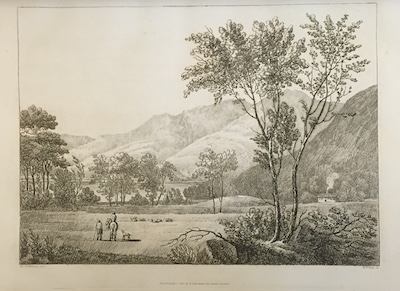
Such a timeline, however, is contradicted by a sui generis, and generally overlooked, copy of Select Views at the Yale Center for British Art. Originally owned by Wilkinson’s Thetford neighbors the “Ladies FitzRoy” of Euston Hall, this is the only known set where all twelve monthly numbers were never removed from their original shipping wrappers. Consequently, this set allows us for the first time to pinpoint the serialization schedule for every plate and letterpress page in Select Views. As revealed by the unopened installments and detailed in the table that ends this appendix, the first seven monthly shipments (January through July) brought four Wilkinson prints and four consecutive pages of Wordsworth’s “Introduction.”
The first departure from this norm came in August, when subscribers received the final six pages of Wordsworth’s introductory section, only three prints, and a note from Wilkinson explaining that a fourth print was delayed due to “an Accident to the Plate of Furness Abbey” (fig. 4). In light of these details, it becomes clear that if, in fact, it was the full text of Wordsworth’s “Introduction” that Lady Beaumont read “with so much pleasure” in early May, it must have been in manuscript rather than published form. For, as the FitzRoy set demonstrates, only twenty pages had been published by 1 May and another three months would pass before all thirty-four pages of the “Introduction” would be available in print.
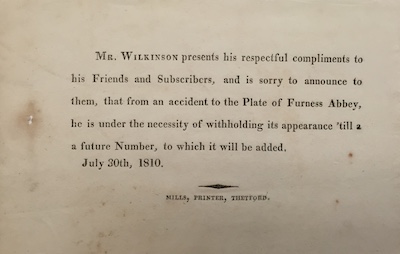
The FitzRoy copy at Yale also shows that, while Wilkinson’s two-page dedication shipped with the January number, his title and contents pages were, in keeping with custom, withheld until the last installment of December. As for the hodge-podge of “descriptions” Wordsworth—with considerable assistance from his sister, Dorothy—begrudgingly wrote after completing his “Introduction,” the two-page-long “Section I” appeared in September, the first four pages of “Section II” in October, and—following the conspicuous absence of letterpress pages in November—the concluding six pages of “Section II” in December.
More generally, this remarkable set at Yale suggests the diverse motivations, not always grounded in aesthetic taste, that could impel well-heeled Britons to subscribe to such a series. While we know little about Wilkinson’s relationship with the FitzRoys, that no member of their household deigned to open even a single installment of Select Views suggests their subscription owed more to neighborly duty or noblesse oblige than to heartfelt admiration for the rector’s art. Oddly, though, despite the family’s apparent apathy toward Wilkinson’s drawings, they went a step beyond subscribing, arranging to have all forty-eight plates hand-colored before leaving Ackermann’s shop.
In the run-up to publication, advertisements for Select Views warned that the series would either be unavailable or would cost considerably more after the subscriber deadline. This proved a bluff, as in coming years Ackermann advertised leftover sets “in boards” for the same £6.6s. paid by original subscribers.
Even that price may have proven too high, though, as deeply discounted second-hand copies began showing up in estate-sale advertisements and book catalogues by the mid-1810s. In 1816, for instance, the Newcastle bookseller Emerson Charnley advertised two used sets of Select Views, one “elegantly half-bound in Russia” leather for £3.13s.6d and another still sewn in its original wrappers for £3.3s. A year later, Richard Priestley of London shaved an additional 30% off the original price, offering a pre-owned set for £2.12s.6d. In ensuing decades, not even increasing awareness of Wordsworth’s connection to Select Views could check this trend, as second-hand sets in boards went for £1.1s. in 1837 and 10s.6d. in 1851. This depreciation continued into the early twentieth century, when bound copies were advertised for 12s. in 1903 and 18s. in 1917.
Testifying, however, to the ongoing vagaries of the antiquarian book market, surviving copies of Select Views have since regained their value and then some. At this writing in early 2020, online dealers are asking £45 for individual Wilkinson prints from a dissembled copy of Select Views, £1,200 for a bound copy of his 1821 reprint, and £1,800 for an 1810 set still in boards. Presumably, much of this surge in prices can be chalked up to Wordsworth’s enduring importance in literary studies and the increased scarcity brought on by university libraries scooping up and locking away many of the copies that come up for sale.
Chronology of the Serialization of Select Views
[Note: The numbers provided for specific engravings reflect the order in which they were reorganized in the table of contents for Select Views. Spelling and capitalization in this table correspond with the original shipping wrappers.After August, the letterpress’s pagination inexplicably shifted from Roman to Arabic numerals]
|
Month (1810) |
Engravings |
Letterpress Pages |
|
January |
45. View near Brothers-water
40. Ennerdale Broad-water
22. Derwent-water, from Applethwaite
26. Cottages at Braithwaite
|
Dedication to Wallace (2 pages)
Introduction (4 pages: i–iv)
|
|
February |
24. Cottages in Applethwaite, looking from Skiddaw
32. View in the Vale of Newlands
30. Cottage in the Vale of Newlands, with Robinson’s-crag
17. Therl-mere or Leath-water
|
Introduction (4 pages: v–viii) |
|
March |
20. View in St. John’s Vale, with Green-crag &c.
33. View on the Grange-river Borrowdale, looking towards Derwent-water
34. View on the Grange-river Borrowdale
29. Cottage in the Vale of Newlands, near Stare-bridge
|
Introduction (4 pages: ix–xii) |
|
April |
43. Stye-Head Tarn, with Aron, or Great-End, above Borrowdale
25. Cottages at Braithwaite
42. View on the Banks of Wast-Water
21. View in St. John’s Vale, near Wanthwaite
|
Introduction (4 pages: xiii–xvi) |
|
May |
12. Langdale Chapel, Vale of Langdale
27. Scale, or Skell-gill Farm House, above Portinscale
35. View near Seatoller, Borrowdale
19. Legbethwaite Mill, St. John’s Vale, taken after much rain
|
Introduction (4 pages: xvii–xx) |
|
June |
41. Wast-water, looking up to Wast-dale Head
18. View on the Ambleside road, near Bridge foot, with part of St. John’s Vale
23. Part of Skiddaw, from Applethwaite Gill
28. Stony-croft Bridge, Vale of Newlands
|
Introduction (4 pages: xxi–xxiv) |
|
July |
38. Bassenthwaite Lake, from Embleton Vale
1. Vale of the Lune, Lonsdale, looking towards Ingleborough Hill & Hornby Castle
8. Esthwaite-water from below Bellemount
37. Smelting Mill, near Thornthwaite
|
Introduction (4 pages: xxvi–xxviii) |
|
August |
48. Lanercost Priory, Cumberland
47. Hawes-water
4. View on Coniston-water
Apology slip for missing fourth plate (Furness Abbey)
|
Introduction (6 pages: xxiv–xxxv) |
|
September |
2. South view of Furness Abby, Lancashire
3. Penny bridge, between Ulverstone & Coniston, with the tide in
5. Coniston Water-head
10. Newby bridge, foot of Winandermere
9. View on Windandermere
|
Section I (2 pages: 35–36) |
|
October |
7. View on the banks of Coniston-water
16. Dunmail raise, on the Ambleside Road
39. Cottages in the Vale of Lorton
44. Lyulph’s Tower, Ullswater
|
Section II (4 pages: 37–40) |
|
November |
36. View above Seatoller, Borrowdale
6. Cottage at Nebthit with Backbarrow-crag
15. Cottage near Rydal
11. Cottages at Ambleside
|
None |
|
December |
46. View on Kirkstone, between Ambleside and Patterdale
14. Brathay-bridge, near Ambleside
31. Cottage in the vale of Newlands, between Keswick and Buttermere
13. Elter Water
|
Title Page
Contents Page
Section II (6 pages: 41–46)
|

